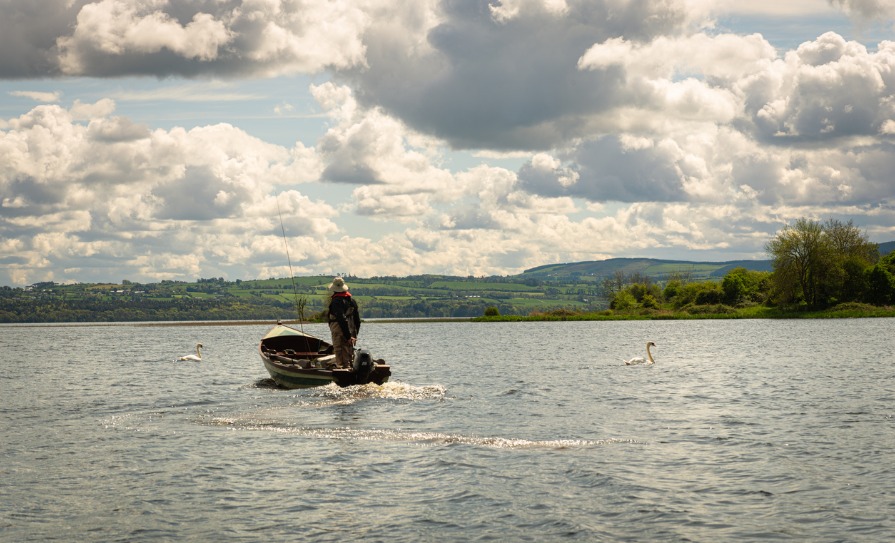
There’s nothing quite like the feeling of sailing with like-minded people
The first time I went sailing, I loved it. I’m not from a sailing family. As a kid, I went out on other people’s boats and it was great: The wind in the sails, travelling through the water to anywhere and nowhere. There weren’t too many ways to get into sailing back then. The main one was Glenans Irish Sailing Club. We slept on bunks in dormitories, took turns to cook, and we sailed. I learned about port and starboard, bow and stern, mainsail and jib. I discovered the important difference between tacking and gybing. I reefed the mainsail and changed the headsail. Where’s the wind? What’s the weather forecast? How’s the craic? Glenans wasn’t luxurious or elegant, but it was affordable, and it was fun, and that’s how a generation of Irish people got out in boats.
The first time I sailed on Lough Derg was in a Glenans boat. It was January, so cold the harbour in Mountshannon was lightly frozen. As we sailed out, there was a gentle “chink, chink” as our bow cut through the thin ice. No engine, no toilet, no heating; just a single ring stove to cook on. No, this is not the penitential Lough Derg – that’s in Donegal.
Fast forward some years, I moved to Nenagh Hospital and lived on the shores of Lough Derg. I bought a small sailing cruiser, a Jaguar 22. There was an engine, a basic toilet, and a methylated spirits stove to cook on. It was a lovely boat for day sailing, and for weekends exploring Lough Derg with friends; on a 22ft boat, if you’re not close beforehand, you will be afterwards. On the water everyone’s a neighbour, from Portumna at the top of the lake down to Killaloe at the bottom, but especially in the little lakeshore villages – Mountshannon, Garrykennedy, Terryglass, and of course, Dromineer, where I now live.
I joined Lough Derg Yacht Club and that’s where I first sailed in a Shannon One Design. The Shannons, also fondly known as SODs, are beautiful hand-crafted wooden boats with a single, very large sail. Designed 100 years ago, but still being built today, they are racing machines. It’s a wonderful sight to see a fleet of graceful Shannons, old and new, chasing each other across Dromineer Bay, around Goose Island, and back to the Club. Shannons often belong to families, handed down between generations, and frequently sailed by those generations together: Grandparent on the helm, son or daughter as sheet-hand, a grandchild as third-hand, and all of them nifty sailors. Dogs have been seen aboard too.
Life moved away from sailing. I got involved in the Irish Medical Organisation and health service stuff. The Jaguar 22 was sitting sadly on a trailer until someone took her on as a rehab project. I didn’t sail and I wasn’t out in any boat for almost 10 years. After such a long gap, where to start? Unfortunately, Shannons have a few drawbacks. They are tough on the knees, as you move constantly in and out to keep the boat level as she flies along. If you don’t, because of the over-sized sail, there’s a very real risk of capsize. Hmm, I’d rather not.
So, for my newest sailing adventure, I’m immersed in the world of Squibs and a (part) boat owner again. A Squib has a keel, so it’s pretty stable. There’s no cabin, no engine, just endless ropes. I’m learning about barber-haulers and the traveller, graduating to discussions of rig tension, and then there’s the spinnaker. On a Squib, one person is the helm, the other flies the ‘kite’. My sailing partner Anne has long experience of spinnakers, so unexpectedly that puts me in the helm seat. It’s a steep learning curve. There’s so much to learn, about the boat, the lake, and about racing rules. Sailing a Squib is easy. Sailing a Squib well, is hard.
I’m used to crewing in a Shannon, with the helm making most of the decisions. In contrast, on our boat there’s a dialogue on what to do. Often I yell “Anne, what’ll I do?” as we sail on port tack (yet again) through a series of boats with right of way on starboard tack. The usual answer is a brisk “Keep going!” Recently, in strong winds out in the middle of the lake, that was followed almost immediately by “Tack! Tack! Tack!” and a close encounter at speed with another boat was narrowly avoided. It’s not for the faint-hearted. It’s exhilarating and it’s exhausting. Then it’s time to recover over a barbeque back at the Club and trade stories of what might have been. Sailing with like-minded people in friendly fleets on Lough Derg is great. There’s nothing like it.





Leave a Reply
You must be logged in to post a comment.